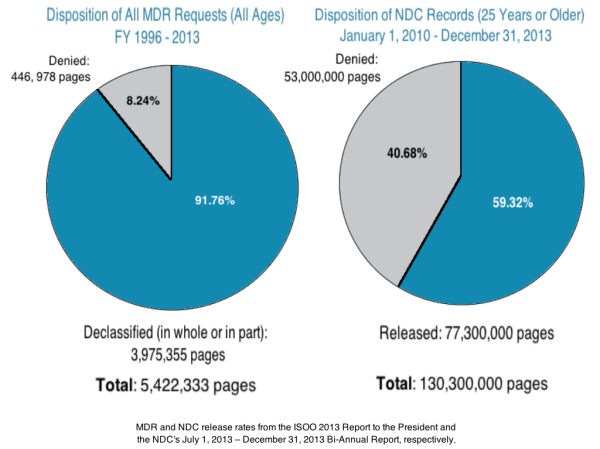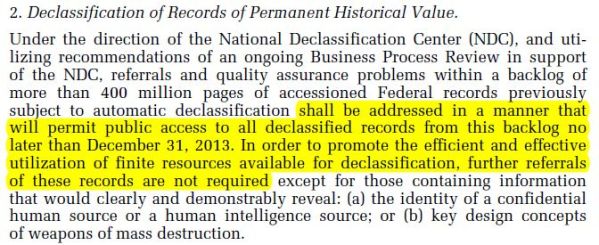National Declassification Center Not Yet “Releasing All It Can”

The current process for 25-year automatic declassification review, found in the PIDB’s December 2014 Report – and a prime example of why the NDC is not yet living up to its potential.
A version of this article originally appeared in The Federalist.
The National Declassification Center (NDC), governed by the National Archives and Records Administration (NARA), has the potential to become President Obama’s largest, longest-lasting, and most important transparency initiative. The NDC has made important strides over the past six years, but important steps remain to ensure that the Center actually fulfills its mission to “release all we can, and protect what we must.”
According to the most recently available public figures, the NDC has “successfully” reviewed 352 million pages of classified records since 2010. Of these, 222 million pages have completed the NDC’s declassification review but have not completed NARA’s boxing and processing procedures—and possibly another Department of Energy review. Of the remaining 130 million pages that the NDC has reviewed, only 77 million pages (just 59 percent) were actually declassified. The remaining 53 million pages were returned to their sensitive compartmented information facilities, where they will await re-review at some future point.
This 59-percent release rate is troublingly low. A comparison with government-wide Mandatory Declassification Review (MDR) request figures reveals that documents requested under MDR are released to the public in whole or in part over 94 percent of the time. The MDR release rate would be even higher if the processing included only documents 25 years old or older, as the NDC does.

NDC release rates of historic documents (right chart) are lower than the release rate of current documents due to equity re-reviews and page level declassification.
The primary reason for the NDC’s unacceptable rate of censorship is its use of a page-level “pass/fail” declassification review process. As the Public Interest Declassification Board (PIDB), the government declassification watchdog, recently explained, “a single word in a record determined to require continued classification beyond 25 years will cause the entire record to ‘fail.’ This process, originally designed by agencies to conserve limited resources, actually does the opposite.” Instead of promoting declassification, this “page by page” shortcut shoves these historic documents back into the vaults (still classified) until a requester requests another “wasteful, expensive” re-review. It also appears to directly contradict the NDC’s mission to “release all we can.”
At an April 2015 public forum on the NDC’s prioritization process hosted by the National Archives, members of the public strongly reiterated that any other reforms are secondary to the need to end page-level “pass/fail review,” which will lift the NDC’s declassification rate to the much more acceptable government declassification rate of 94 percent.

The Public Interest Declassification Board’s recommendation for the “prioritization for the most historically significant and sought-after information the public desires.”
While the NDC has not yet ended “pass/fail review,” soon after the April meeting, the Center took the important step of listing the titles of record series processed for declassification—but not yet publicly available—on its website so that users can know what the NDC has processed. Even better, the NDC now institutes “indexing on demand” wherein researchers can request access to these previously unavailable records and—if they have been declassified—view them within days.
Also promisingly, the NDC is currently embarking on other reforms to improve its efficiency. Another major criticism of the NDC in the PIDB report was that the NDC relies on the wasteful equity referral and consultation re-review process, wherein multiple reviewers from multiple agencies (such as the CIA, NSA, and State Department) are allowed to re-review the same document multiple times. “Clinging to manually-intensive processes diverts increasing dwindling resources,” the PIDB writes, “There must be an understanding and agreement that the current practice of having one, two or more persons conduct a laborious page-by-page declassification assessment for each record under review is an unsustainable practice.“
President Obama also envisioned an end to this process at the NDC. The president instructed the NDC that “further referrals of these records are not required except for those containing information that would clearly and demonstrably reveal [confidential human sources or key WMD design concepts].” Previous large declassification review projects have also shown that a “one set of eyes–one decision” review is possible, effective, and desirable. Both the JFK Assassination Records Review Board and (to a lesser extent) the Nazi War Crimes and Japanese Imperial Government Records Interagency Working Group have shown that declassifiers can effectively be unleashed from the bonds of mandated equity re-review.

Presidential Memorandum – Implementation of the Executive Order, “Classified National Security Information”
Thankfully, if belatedly, the National Declassification Center is beginning to slowly reduce equity re-reviews. Now, after agencies are alerted by the NDC about documents that they may have “equity interest” in, agencies are given a hard deadline of one year to review. If they do not review the documents within that period, agencies will lose their ability to claim an “equity,” and the NDC will use its authority for release. While this reform still falls short of the “one document, one review” ideal espoused by the PIDB, President Obama, and other advocates, it is a step in the right direction of increased declassification efficiency and increased NDC authority. Hopefully more steps will follow.
The NDC also reports that it is improving its methods to prioritize which series of records are scheduled for declassification. Researchers of the 77 million pages declassified so far have described them as “low hanging fruit.” Indeed, one early NDC report stated that just one percent of all documents in the backlog were “high interest, easy to process.” This means “high interest documents were very likely to be withheld under ‘pass/fail’ review.”
While some have warned of the potential danger of damaging archival provenance by selection of prioritized series (“Swiss cheese declassification”)—and it would be a critical mistake to corrupt the provenance of record series—series-level prioritization will ensure that the NDC’s resources are going to the documents most in demand and that will be most viewed by the public.
Perhaps the best candidates for series-level declassification by the NDC are the records held by NARA’s presidential libraries, the bulk of which are being declassified at a glacial pace due to lack of resources, apparent lack of urgency, and the wasteful equity referral re-review system.
After presidential records, the NDC should consider the declassification of records from principal policy makers, including records of the Secretary of State, Secretary of Defense, Chairman and Joint Chiefs of Staff, and the director of the Arms Control and Disarmament Agency. Because policy makers impact a broad range of issues, declassification of their records will meet a wide variety of researcher interests in terms of geographic and topical subject areas.
The National Declassification Center also has the important opportunity to gain public support and demonstrate its declassification clout by using its authority to declassify the remaining 1,171 distinct documents related to the John F. Kennedy assassination held by the National Archives whose release to the public was postponed until as late as 2017.
Despite criticisms of the National Declassification Center’s low release rate and inability to declassify high-interest documents, it is heartening to see one of President Obama’s most important transparency initiatives continue to improve. Archivists, researchers, historians, and public access advocates must work to ensure that it is preserved—and funded—into the next administration and beyond. If the NDC improves the speed, efficiency, quality, and quantity of its declassification reviews, it will make it all the easier to advocate for.
Comments are closed.

Reblogged this on Advice You Didn't Seek: and commented:
“Secrecy” as practiced by the US government, particularly but not exclusively the Intelligence Community, is the basis of many public concerns. If a concerted, rigorous and and expedited (over the current pace) effort were made I believe it would dissipate most but not all public concerns. It should include an individual’s being able to request an expeditious review of their records that no longer require classification.